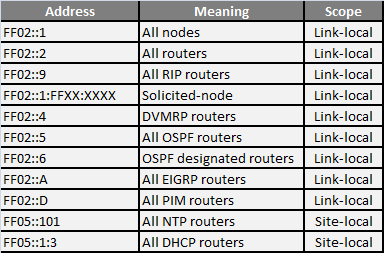Let’s keep going and finish IPv6 introduction.
Multicast
A multicast address identifies a group of interfaces. Traffic, that is sent to a multicast address, is sent to multiple destinations at the same time. An interface may belong to any number of multicast groups. Multicast addresses are defined by the prefix FF00::/8.

The second octet defines the flags and the scope of the multicast address. Flags can be defined as:
- 0 is reserved and must equal 0
- R indicates rendezvous point and is almost always set to 0
- P indicates prefix dependency and is almost always set to 0
- T is the temporary bit. For a temporary multicast address T equals 1; for a permanent multicast address T equals 0.
Scope can be defined as:
- 1 – interface-local, for the scope of the interface (loopback transmission)
- 2 – link-local, for the link scope
- 3 – subnet-local, for the subnet-local scope (subnet can span multiple links)
- 4 – admin-local, for the administrative-local scope (administratively configured)
- 5 – site-local, for the site scope
- 8 – organization, for the organizational scope (multiple sites)
- E – global, for the global scope
The multicast addresses FF00:: to FF0F:: are reserved. Inside this range, the following addresses are assigned:

Anycast
An IPv6 anycast address is assigned to an interface on more than one node. Packet sent to an anycast address is routed to the nearest interface that has that address. The nearest interface is found according to the measure of distance of the routing protocol. For IPv6, anycast is defined as a way to send a packet to the nearest interface, that is a member of the anycast group. Anycast addresses are allocated from the unicast address space, so they are indistinguishable from the regular unicast address space.
 Labnario Huawei From Scratch
Labnario Huawei From Scratch